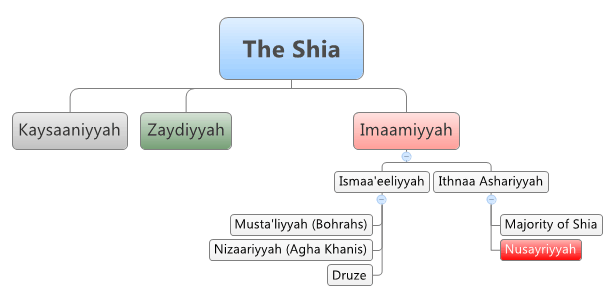| Saturday, 12 July 2025 |
|
|
|
|
You are here:
Home  Sects
Sects
 There are many Shia sects in history and the Shias have historically always splintered because of the very nature of their fundamental doctrine of Imamate (leadership). In this article we want to briefly, gain a broad overview of a general classification of the Shia. Diagrammatical Representation In order to help you see a birdseye view we present the following diagram:
 Brief Details on the Sects First, we have the Kaysaaniyyah:
They are ascribed to Kaysaan who is the mawlaa of Ali (radiallaahu anhu), and also the student of Muhammad bin al-Hanafiyyah (son of Ali). The core belief of this sect is that Ali (radiallaahu anhu) encompassed all the divine knowledge, and he knows all the secret hidden ta'weels (explanations, exegesis), and that he alone has the right to make interpretations of the Shariah texts, and obedience to this Imaam is the very essence of the religion (and which in turn invalidates the necessity of the legislated actions). Muhammad bin al-Hanafiyyah freed himself from these people openly, however when he died, they claimed he is still living and that he will be given the permission to return. To the Kaysaaniyyah, Muhammad bin al-Hanafiyyah is the awaited Mahdi. Note the diffrence between this sect and others in that they only said Ali (radiallaahu anhu) possessed the divine knowledge, but did not actually deify him. Second, we have the Zaydiyyah:
And they ascribe to Zayd bin Ali bin al-Husayn bin Ali bin Abi Talib. Whilst they believe in the superiority of Ali (radiallaahu anhu), they also accept the principle that a person of lesser rank is able to take leadership despite the presence of the one with higher rank due to some considered beneficial interest which needed to be attained on account of the situation of presence of factors. This is how they view the rulership of Abu Bakr, Umar and Uthman (radiallaahu anhum). When the Shias of Kufah heard of this position and that they do not free themselves of the two Shaykhs (Abu Bakr and Umar), they rejected them and so the Zaydiyyah labelled them "Raafidah." Zayd bin Ali bin al-Husayn studied with Wasil bin Ataa (founder of the Mu'tazilah), there were elements of i'tizaal (rationalism) as well as aspects of khurooj (revolt of the Kharijites), although he was not upon the actual core usool of the Mu'tazilah and Kharijites, and for this reason, traces of these influences are found in the Zaydee fiqh and manhaj. The Zaydiyyah are the least deviant faction of the Shi'a. Third, we have the Imaamiyyah Shias:
These are of numerous sects as we shall see, but they carried the right of Imaamah (leadership) from Ali to his son Hasan, to his brother Husayn to his son Zayn al-Aabideen and then to his son Muhammad al-Baaqir, then to his son Ja'far al-Saadiq (may Allaah be pleased with them all). From here, they divided into two categories: Fourth, we have the Nusayriyyah:
They are an extreme splinter group from the Imaamiyyah, Ithna Ashariyyah sect of the Shia and they appeared in the third-century hijrah, named after Muhammad bin Nusayr al-Numayree. They claim Allaah indwelled in Ali (radiallaahu anhu), they also believe in the transmigration of souls (tanaasukh al-arwaah) and also believe in secret esoteric interpretations of the Qur'an. The entire set of beliefs they hold are an amalgamation of idol-worship, Magian paganism, and Jewish and Christian doctrines. They conceal their doctrines from those outside of their circles, and historically have killed those who dared to leak their secrets.
Link to this article: Show: HTML Link • Full Link • Short Link
Add a Comment You must be registered and logged in to comment. |
|
||||||||||||||||
 |
 | |
|
|







